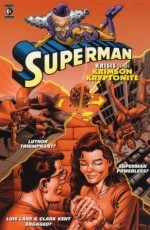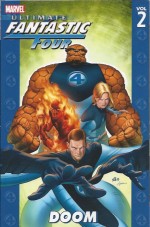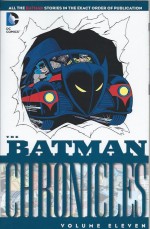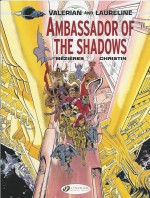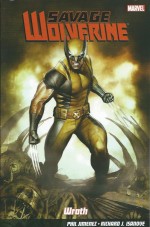

By Frank Miller, Klaus Janson & Lynn Varley (DC Comics)
Item ISBN: 0-930289-15-3,              current ISBN: 978-1-56389-342-1
I always feel a bit daft reviewing stuff that everyone already knows about, but I’m constantly being reminded that even though somebody talks about the classics of our art-form it doesn’t mean they actually have read them.
Moreover, the great thing about comics is that they’re meant to be re-experienced, over and over and over…
So here’s a quick look at Frank Miller’s most celebrated epic: a canny mix of iconoclastic bravura and contemporary dystopian angst blending urban anxiety with bleak wish-fulfilment power-fantasies and making all us whiny liberals love it anyway…
There had been many “Last Batman†stories over the decades since his creation in 1939 but none had the telling impact of the 4-issue “Prestige Format†miniseries which ran from February to June 1986, during a period when DC were creatively on fire and could do no wrong commercially…
The subsequent collection into a complete edition did much to kick off the still tentative graphic novel market, offering a plethora of different versions at the time: hardcover, paperback, bookstore editions, foreign language editions – and an Absolute Dark Knight edition, in 2008 – all proving how a single story could be successfully monetised to the benefit of all, except the poor bewildered fans who clung tenaciously to the cruelly punishing collectors’ credo “gotta have ’em allâ€â€¦
(There are a number of editions available to this day, but I’m concentrating here on my first edition hardback from 1986. Therefore, some of the ancillary features and articles might be omitted, augmented or replaced in later releases…)
The epic transformed the character as much as the industry, with writers adapting facets of the chaos and carnage-resisting, end-of-days Caped Crusader to subsequent in-continuity tales whilst the readership spent years looking for clues in the regular comics that the story would eventually become canonical…
After Alan Moore’s Introduction ‘The Mark of the Batman’ the challenge to a civilisation in crisis begins with ‘The Dark Knight Returns’ as Gotham swelters under a crippling heat wave and ubiquitous TV pundits jabber on incessantly, disseminating what the government allows to pass for news.
Aging playboy Bruce Wayne (55 and no longer counting) has narrowly escaped blazing death during a car race, street gang The Mutants have perpetrated another ghastly atrocity and long-past-it Police Commissioner James Gordon has challenged them to a showdown before his enforced retirement in four weeks.
It’s also the tenth anniversary of the last sighting of the fabled masked vigilante the Batman…
Later that night Wayne and Gordon talk over old times but the billionaire’s journey home is interrupted by a pack of Mutants…
On the nightly News homicidal maniac Harvey Dent is paraded by arrogant surgeons and therapists as a shining example of their restorative and curative regimes. Two-Face is now a fully rehabilitated citizen ready to reclaim his place in the world…
Back at the Manor, as the TV disgorges a litany of tragedy and travesty, a grumbling urge that has been boiling in Wayne’s gut for a decade finally breaks loose and decrepit manservant Alfred realises with dismay and disgust that Bruce’s other self is coming back…
Whilst a storm breaks over Gotham the night is filled with the screams and the cracking of bones as a horde of violent thieves and thugs are brutalised. Wayward 13-year old Carrie Kelley is saved from a pack of Mutant chickenhawks by a merciless shadow and the News is filled with reports of gangsters reduced to cripples by a maniac “dressed like Draculaâ€â€¦
When the savage shadow foils a bank raid, one of the hoodlums has a coin with the heads-side scarred and defaced.
…And in Arkham Asylum‘s quiet-ward an old, mute cripple with fading green hair watches the News, smiling and laughing for the first time in a decade…
That night the public gets its first full view of the unfolding situation as Two-Face holds Gotham’s Twin Towers hostage and Batman spectacularly ends his campaign of explosive extortion…
‘The Dark Knight Triumphant’ opens to public and media uproar as the Batman’s latest exploits galvanise the Man in the Street, the cops and especially psychotic monsters like the leader of the Mutants – who offers a terrifying challenge to the citizens and their returned hero.
Carrie Kelley rises to that challenge, buying a Robin outfit and jumping over rooftops looking to help clean up the city. Batman doesn’t have time for nonsense and hot air. He’s an old man with a dodgy heart who knows his days are already numbered.
All he wants is to get through another night and punish the Mutants who kidnapped a little boy…
Government – Federal and local – remains stonily silent on the issue of Batman (the first masked hero to break ranks since the government outlawed them years ago) and tension and unrest only escalates when a subway commuter is blown up by the Mutants…
At long last the Mayor acts, appointing Captain Ellen Yindel as his new Commissioner of Police. Her first act is to issue an arrest warrant for The Batman on assault and sundry other charges.
The subject of the manhunt doesn’t care: he’s engaged in a savage battle with the Mutant Army, his bat-tank and gadgets decimating the feral thugs at the City Dump.
His big mistake is to engage their leader in hand-to-hand combat. The steroid and rage fuelled gangbanger is a hate-propelled mass of muscle and speed, half his age and utterly immune to the Dark Knight’s every fighting trick and stratagem.
He is moments from beating the old fool to death when Robin introduces herself to her hero by causing an explosive distraction and stealing the battered body. Guided back to the Batcave, she can only watch as Alfred stitches the broken sack of meat and bone back together for the millionth time…
In the White House the American President takes extreme action, sanctioning the colourful assistance of the Nation’s Kryptonian Secret Weapon whilst in Arkham Dr. Bartholomew Wolper – the man who “cured†Two-Face – continues his treatment of the newly reinvigorated inmate once known as The Joker, whilst in the streets a growing number of Batman imitators take the law into their own increasingly bloody hands.
Although not fully recovered, Batman and Robin are forced to strike again when the Mutant Leader murders the Mayor with his teeth. The old campaigner orchestrates a showdown in front of the entire Mutant nation who watch in astonishment as their unbeatable ruler is methodically taken apart and left a crippled wreck by the resurgent, unholy Warrior Bat…
The beginning of the End starts with ‘Hunt the Dark Knight’ as Gotham is beset by more urban violence as the Mutants splinter into smaller fringe gangs. More worrisome is the huge uptick in citizen violence as the ordinary, decent folk of Gotham get out their legally purchased guns and start shooting at anyone who threatens, frightens, annoys or disgusts them.
The strangest result of the leader’s fall is the declaration by a hard core of former Mutants who publicly convert to “Sons of the Batâ€, dedicated to carrying on the Dark Knight’s work: channelling their need for violence into excessive force applied to all malefactors from murderers to jaywalkers…
The Government is far more concerned with the deteriorating international crisis and The Batman is otherwise occupied. As well as cleaning up street scum whilst avoiding the police trying to catch him, there is fresh hell unleashed when the Joker hijacks Gordon’s televised retirement party and incoming Commissioner Yindel’s moment of glory with an explosively gory statement of his own…
With Armageddon clearly coming, clandestine Federal operative Clark Kent takes time out from a very busy schedule of secretly thwarting Soviet military strikes across the world to give old comrade Bruce Wayne a very clear cease-and-desist-or-else message from the White House. Naturally he is utterly ignored…
When the Joker is interviewed on a hugely popular talk show, Yindel’s squads are ready for Batman’s inevitable intervention but not the appalling atrocity the Clown Prince has engineered. In the bloodbath that follows, the openly suicidal Harlequin of Hate pushes himself to even greater excesses after abducting High Society Madam Selina Kyle and instigating another murder spree…
With the gung-ho cops dogging Batman’s heels the bloody trail leads to Gotham County Fair and a horrific, breathtaking final confrontation…
The final chapter then opens with Batman as Public Enemy Number One and a desperate fugitive. The warrants now read “murderâ€â€¦
Elsewhere Superman prevents nuclear devastation by diverting a Soviet mega-warhead but the explosion radically weakens him. Despite this the Good Soldier obeys his Commander-in-Chief’s next order… stop Batman…
The world is in total chaos as fallout and electromagnetic disturbances bring about a nuclear winter and fry most electrical systems. The Caped Crusader, however, has always been a planner and has an arsenal of weapons and a small core of converts ready for the world that survives.
He also has a hidden ally. Radical firebrand Oliver Queen used to be the heroic Green Arrow…until Superman maimed the intransigent rabble-rouser who refused to toe the Government line once too often…
All that’s left is the final apocalyptic duel between two old, broken and dying heroes defending to the death their respective visions of justice. Despite a phenomenal showing, at last ‘The Dark Knight Falls’, but there’s still one last surprise in store…
Peppered with barbed and biting cultural commentary courtesy of the perpetual vox-pop of talking heads incessantly interviewed by the caustically lampooned and satirised news media, bombarding the reader with key narrative information in subtly layered levels and periodically enhanced throughout by stunningly iconic and powerful full-page tableaux, The Dark Knight Returns ushered in a new style of storytelling and made comics something adults outside the comics industry simply had to acknowledge.
Mythic, challenging and staggeringly visceral, this is rightly the Batman book everyone has heard of. Why not read it at last and see why?
© 1986 DC Comics, Inc. All Rights Reserved.


